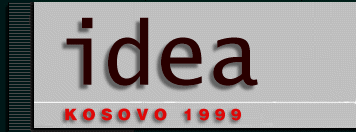


 |
 |
 |
|
|
The Chomsky Article,
"The Current Bombing: Behind the Rhetoric", can be found in
Please send your comments, suggestions, and criticism
to
After the NATO action
against Serbia started,
Yet Mr. Chomsky
accuses not the Serbs
Do not the Serbian
Army and Police forces
Writing in the name of the Left, Mr. Chomsky compares NATO bombardment to: 1) Japan’s attack on Manchuria during the WW-II; 2) Mussolini’s invasion of Ethiopia; 3) Hitler’s occupation of parts of Czechoslovakia. In plain words, NATO is a destructive force in the service of the worst intentions on the part of the North American and European democracies. Serbia is the victim, persecuted by the most aggressive, brutal, and dangerous powers in the world. This is the perception by an anarchist of a mass destruction which, in retrospect, is in no way different from the one that took place in Bosnia just four year ago—except a ‘humanitarian’ aerial bombardment by NATO to stop it. Before the commencement of the NATO aerial bombardment over Yugoslavia, more than 2000 people had been killed and hundreds of thousands forced to leave their homes. Mr. Chomsky opposed to the bombardment which was undertaken to prevent the possible full scale mass destruction. Not because he had a better idea. He found it outright illegal. He proposed simply to DO NOTHING to stop it on the pretext of respecting and strengthening the international law, while the latter, as it was epitomized by the Security Council, would exactly have dictated the same: DO NOTHING, just as it DID NOTHING in the case of Bosnia before.
SERBIAN What was taking place in Kosovo for years was
not a war between the combatants. Neither was it a matter of ‘defending
of Yugoslav territory against the terrorists,’ as Mr. Chomsky wants us
to believe it to be. It was the prelude to a systematic persecution and
destruction of the innocent through the most savage ways humanity is ever
capable of, sponsored by a despotic residue still trying to keep its foot
on the Balkans. It was a continuation of a campaign of hate by a people
which, until it is free from its burden of sadistic impulses against humanity,
it is immoral to recognize as a ‘Nation.’ Until the evil is admitted as
such, the hate will not end but remain repressed. Its political expression,
the will to war, will wait for its time to come once more. But when the
evil is recognized for what it is, when the conscience is let free to do
its job, human nature, which is no doubt shared by the Serbs also, is not
incapable to get rid of it.
If you try to sell this sort of picture as an intellectual commentary, you get a bit nervous. So it is not unpredictable to find a note of hostility being emitted from his sense of guilt between the lines of Mr. Chomsky’s article. To that extent, this essay has its legitimate right to be a bit hostile against the apologetics of mass murder. Normally we can’t feel, we can’t imagine the intensity of the pain and suffering afflicted on a peaceful people of which the only guilt is to have different beliefs and values, a different culture. Normally, the hatred with which the hearts of the mass murderers is filled is beyond the reach of our empathy. We can imagine the victim at the moment the gun is directed to his or her head; but we fail to feel the terror of the moment. If we, or rather, if the Serbs could have, the world certainly would have been a much better place.
In the spring of 1996, as eastern Bosnia's frozen ground was beginning to thaw, a photographer and I drove to Kamenica, a village in Republika Srpska, the Serb-run enclave that was carved out of Bosnia by Serbian ethnic cleansing and later given juridical existence by the 1995 Dayton peace accord. We had been told that Kamenica was the place where Bosnian Serb forces had killed many of the 7,000 Bosnian Muslims who were missing after the Serbs overran the U.N.-protected enclave of Srebrenica the previous summer. We veered off the main road through the village onto a dirt path that led into rolling green hills. A few minutes later, we found ourselves standing on a grassy hillside littered with human bones. Nearly eight months had passed since the men from Srebrenica were killed, and none of the Serbs of Kamenica had thought to bury them. Tennis shoes and woolen socks still hugged skeletal feet. A stretcher made of a blanket and two wooden sticks lay on the ground; the wounded man who had lain on it was now an intact skeleton, still dressed in jeans and a plaid shirt. Skulls, vertebrae, arms, legs, rib cages, rubber boots, bits of clothing, and ID cards were everywhere. And, in a thorny bush at the bottom of the hill, we found an old Polaroid of four men—all presumably victims—laughing and sharing a bottle of beer. As we walked among the dead, two Serb farmers drove past us on a tractor, the tires of their vehicle narrowly missing a corpse that still lay right in the path. They seemed not to notice. A few minutes later, two more young Serb men walked by. I asked the me if they knew what had happened on the hill. They shrugged their shoulders and told us that they had been on vacation in Austria during the summer of 1995. Ever since that encounter, I have been struggling to understand what these men could have been thinking. Even before the current slaughter in Kosovo, Serb forces had killed a massive number of civilians in the name of national self-defense. Yet it has all gone on with barely a murmur of public dissent or protest. Even when I approach Serbs individually, probing them for remorse, I hardly find any. Why not? From ‘‘Milosevic’s Willing Executioners’’
|
|